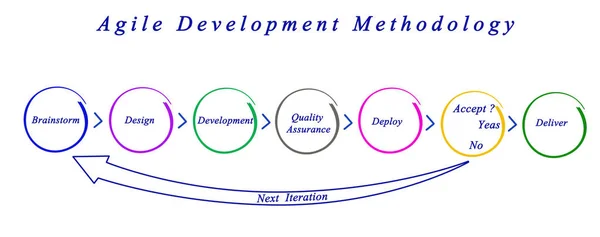Accelerating Product Development with Agile Engineering

In today’s competitive digital landscape, speed and flexibility are essential for staying ahead of the curve. Businesses that can rapidly adapt to changing market demands, technological advances, and customer expectations are better positioned for success. One of the most effective ways to achieve this is through Agile Engineering. Agile methodologies have become a cornerstone of modern product development, enabling teams to shorten development cycles, improve collaboration, and continuously innovate.
At Raphus Solutions, our mission is to help enterprises evolve into digitally-driven organizations with seamless efficiency and innovative products. Agile engineering aligns perfectly with this vision by fostering innovation and accelerating the development of high-quality digital products.
How Agile Methodologies Shorten Product Development Cycles
Agile methodologies prioritize flexibility, collaboration, and customer feedback, which allows for rapid product development and deployment. In contrast to traditional, linear models like Waterfall, where product development happens in distinct, sequential phases, Agile promotes iterative progress with continuous input and improvement.
Here’s how Agile can significantly shorten product development cycles:
1. Iterative Development: Agile teams work in short, iterative cycles called sprints, typically lasting two to four weeks. Each sprint focuses on delivering a set of features or improvements. By breaking down large projects into manageable tasks, teams can make steady progress and ensure that the product evolves in alignment with customer needs. This leads to faster time-to-market and reduces the risk of failure, as problems are addressed early in the process.
2. Continuous Feedback:A key principle of Agile is integrating continuous feedback from stakeholders and customers. By constantly seeking input and incorporating it into the next iteration, teams can refine the product throughout its development. This minimizes the risk of delivering a product that doesn’t meet customer expectations and allows for rapid course corrections.
3. Cross-Functional Collaboration:Agile promotes close collaboration between developers, designers, testers, and business stakeholders. This cross-functional approach ensures that every aspect of the product is considered at every stage of development. Communication barriers are reduced, allowing for faster decision-making and fewer delays.
4. Adaptive Planning:Traditional product development approaches often involve rigid, long-term planning, which can slow down progress when conditions change. Agile, on the other hand, embraces adaptive planning, allowing teams to adjust priorities and strategies based on real-time information. This ensures that teams are always working on the most valuable features, leading to faster and more efficient product development.
5. Reduced Bottlenecks:In Agile, teams work in parallel on different parts of the product, reducing the bottlenecks that typically arise in linear workflows. Continuous integration and delivery (CI/CD) practices further streamline the process, ensuring that features can be developed, tested, and deployed quickly.
Best Practices for Implementing Agile in Large-Scale Engineering Projects
While Agile methodologies are often associated with smaller, more nimble teams, they can also be highly effective in large-scale engineering projects. The key is to adapt the Agile framework to the needs of complex, multi-disciplinary teams without losing the core principles of flexibility and collaboration.
Here are some best practices for implementing Agile in large-scale engineering projects:
1. Scaling Agile Frameworks (SAFe, LeSS, Disciplined Agile Delivery):
When working on large projects, it’s important to implement a scalable Agile framework such as SAFe (Scaled Agile Framework), LeSS (Large Scale Scrum), or Disciplined Agile Delivery (DAD). These frameworks provide guidelines for coordinating multiple Agile teams working in tandem, ensuring that the principles of Agile (continuous delivery, iterative development, and cross-functional collaboration) are maintained at scale.
For instance, SAFe structures teams into different layers (team, program, and portfolio) to manage work efficiently across multiple teams and levels of an organization.
2. Fostering Cross-Team Collaboration:
Large engineering projects often involve multiple teams working on different parts of the product. To ensure cohesion, it’s important to foster communication and collaboration across these teams. Regular Scrum of Scrums meetings—where representatives from each team come together to discuss progress, share updates, and resolve dependencies—can help maintain alignment and prevent silos from forming.
3. Implementing DevOps and CI/CD:
Integrating DevOps practices with Agile is crucial for large-scale engineering projects. DevOps promotes close collaboration between development and operations teams, ensuring that code is tested and deployed continuously. CI/CD (Continuous Integration/Continuous Delivery) pipelines automate much of the testing and deployment process, reducing errors, increasing speed, and ensuring that new features or fixes are deployed without delay.
By automating repetitive tasks, such as testing and deployment, teams can focus on delivering features and improvements, resulting in faster and more reliable product development.
4. Modularizing the Product:
Breaking down large products into smaller, independent modules allows teams to work concurrently on different components. Each module can be developed, tested, and deployed independently, which speeds up the overall product development cycle. This modular approach also makes it easier to test and integrate changes without disrupting the entire system.
5. Using Agile Metrics:
To ensure that Agile principles are being effectively implemented, it’s essential to use metrics to track progress. Key Agile metrics such as velocity, lead time, and cycle time help teams understand how quickly they are delivering features, identify bottlenecks, and make data-driven decisions. By continuously monitoring these metrics, teams can optimize their processes for maximum efficiency.
6. Focusing on the Customer:
Agile is customer-centric, so it’s vital that large-scale projects keep customer needs at the forefront. Regularly seeking feedback from end users, validating features with real customers, and making improvements based on that feedback ensures that the product meets market demands and expectations. This practice, known as user-centered design, is critical for the success of any large-scale Agile project.
Conclusion
Agile Methodologies have transformed the way products are developed, enabling teams to innovate rapidly, adapt to change, and bring products to market faster. By adopting Agile practices such as iterative development, continuous feedback, and cross-functional collaboration, enterprises can accelerate their product development cycles, increase operational efficiency, and enhance customer experiences.
For large-scale engineering projects, the challenge lies in maintaining Agile principles while coordinating the efforts of multiple teams. By implementing scalable Agile frameworks, fostering cross-team collaboration, and using DevOps and CI/CD, enterprises can successfully accelerate their product development even in complex environments.
At Raphus Solutions, we are committed to helping businesses leverage Agile methodologies to accelerate their digital journeys and drive growth. By embracing Agile engineering, organizations can stay ahead of the competition and deliver innovative products that meet the needs of an ever-changing market.



